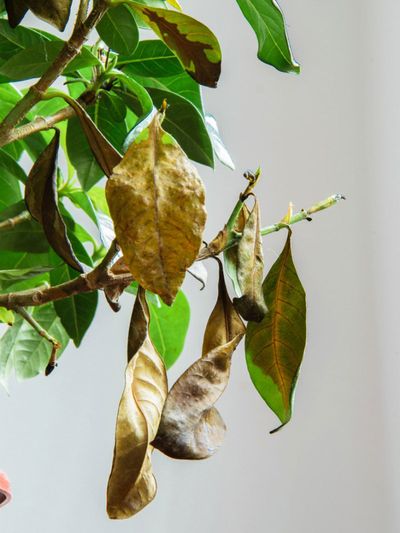What is Chlorosis in Plants?
Chlorosis in plants simply means that the plant doesn’t have enough chlorophyll. This can be caused by poor drainage, root problems, pH too high, not enough nutrients from the soil, or a combination of all of these.
Too much water causing a gardenia bush with yellow leaves
When you have a gardenia bush with yellow leaves, the first thing to do is check your soil for too much water. The gardenia needs moist soil, but not overly wet. Add some more compost to help it have a richer environment and be sure to set up proper drainage.
Wrong pH causing gardenia bush with yellow leaves
Once you determine that water isn’t the issue, you need to check the soil’s pH balance. Soil pH for plants is an important issue for gardenias, which require a pH between 5.0 and 6.5. The effects of soil pH level on plants will cause it to not be able to absorb minerals like iron, nitrogen, magnesium, or zinc. Mineral deficiency is one of the major causes of chlorosis in plants. In gardenias, the most common deficiencies are magnesium (Mg) and iron (Fe), which result in similar leaf yellowing. Treatment for each is dependent on proper identification: Magnesium deficiency – You will see yellow leaves at the base of branches while tips remain green. You may also notice a dark green triangle at the leaf base that may resemble the plant’s leaf shape. A dose of magnesium salt, or Epsom salts, will help. However, keep in mind that excessive applications may leach into soil. Iron deficiency – Tips often turn yellow, but the base of branches and leaf veins remain green. This is most common as weather becomes cooler, since slower plant sap makes it more difficult to take up the nutrient. Therefore, spring is normally deemed the most appropriate time for treatment through the use of chelated iron, which lasts longer and absorbs gradually. Powder form is recommended as liquid types may not have sulfur, which is necessary for lowering pH (iron decreases as pH increases). It can be difficult to balance soil pH for plants. By adding the missing nutrients, you can help reduce yellow leaves on your gardenia. One method is to simply add the right balance of the missing nutrients to the soil around the plant (starting at about 5 feet or 1.5 meters away from the plant). Some people treat the leaves with a water solution of the missing nutrients, but this is a temporary fix at best, as it helps the current foliage turn green again. It is better to adjust the soil pH for plants for long term health. Adding the nutrients directly to the soil, about 3 feet (.9 m.) or further away from the plant where the roots spread out is another way to help eliminated yellow leaves. A gardenia bush with yellow leaves is a common problem and can ultimately be very difficult to fix. If, after your best efforts, your gardenia still does not survive, don’t be too hard on yourself. Even master gardeners with years of experience can lose gardenia bushes despite their best efforts. Gardenias are beautiful but fragile plants.
